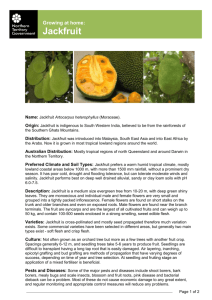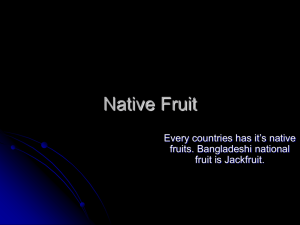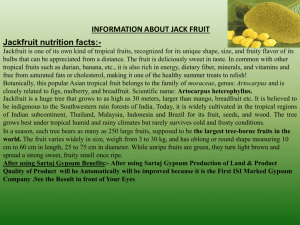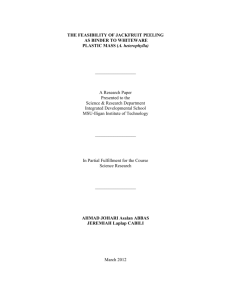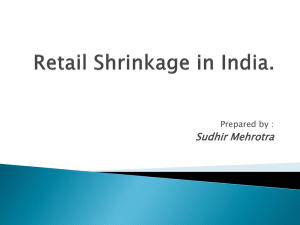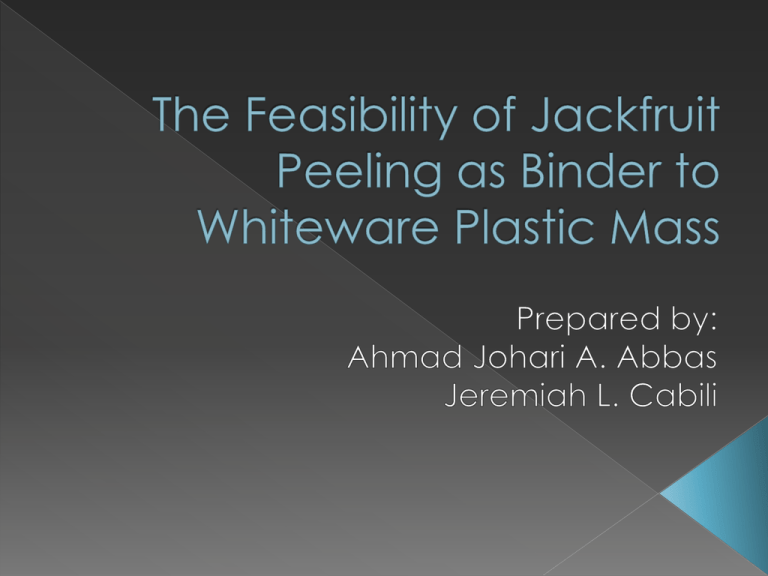
Binders have been called the most
important processing additive during
ceramic sintering process (firing).
Ceramic binders are quite expensive,
reaching from $2000 to $3000 per metric
tons and is multiplied since it is imported
from other countries.
The researchers plan to produce an
alternative binder utilizing jackfruit
peeling as the raw material.
The
study will evaluate the feasibility of
the Jackfruit peeling as an effective
raw material in the formulation of
alternative ceramic binder to
standard whiteware plastic mass.
The study will only encompass the
utilization of jackfruit peeling as an
ALTERNATIVE CERAMIC BINDER.
Shrinkage (%drying and %firing
shrinkage), %loss on ignition and modulus
of rupture of the standard whiteware
plastic mass formed using the binder
utilized from the jackfruit peeling will be
determined.
300g jackfruit pulp &
350 ml water
Ground (Blender)
1500 ml jackfruit pulp
Strained (Strainer)
1000 ml jackfruit pulp
(ready for use)
Figure 1.1
Preparation of
Jackfruit Pulp as
Binder
Forming the Plastic Mass using two
different treatments. (Water and jackfruit
pulp as binders)
Determination of %drying shrinkage
of the test bars in each of the two
treatments.
Determination of %firing shrinkage
of the test bars in each of the two
treatments
Figure 1.2 Experimental
Methodology
Determination of %loss
on ignition of the test
bars in each of the two
treatments
Determination of
Modulus of Rupture of
the test bars in each of
the two treatments.
Firing Set-up
Fired Test Bars
Measuring Length
using Vernier Caliper
Wieghing of
test bars
Modulus of Rupture Test
using Versa Loader with
improvised attachments
Test Bar
W1
W2
W3
W4
W5
W6
W7
W8
W9
W10
W11
W12
W13
W14
Initial
Oven-dried
Length
Length
(cm)
(cm)
17
15.6
17
15.6
17
15.5
17
15.4
17
15.4
17
15.5
17
15.4
17
15.4
17
15.4
17
15.4
17
15.5
17
15.5
17
15.4
17
15.5
Fired
%Drying
%Firing
Length
Shrinkage Shrinkage
(cm)
15.5
8.24
0.64
15.6
8.24
0.00
15.3
8.82
1.29
15.3
9.41
0.65
15.2
9.41
1.30
15.3
8.82
1.29
15.1
9.41
1.95
15.2
9.41
1.30
15.4
9.41
0.00
15.3
9.41
0.65
15.3
8.82
1.29
15.2
8.82
1.94
15
9.41
2.60
15.4
8.82
0.65
Test Bar
J1
J2
J3
J4
J5
J6
J7
J8
J9
J10
J11
J12
J13
J14
Initial
Oven-dried
Length
Length
(cm)
(cm)
17
15.1
17
15.2
17
15.2
17
15
17
15.1
17
15.4
17
15.2
17
15.4
17
15.2
17
15.2
17
15
17
15.2
17
15.3
17
15.2
Fired
%Drying
%Firing
Length
Shrinkage Shrinkage
(cm)
14.7
11.18
2.65
14.8
10.59
2.63
14.8
10.59
2.63
14.9
11.76
0.67
14.9
11.18
1.32
15
9.41
2.60
14.8
10.59
2.63
14.9
9.41
3.25
14.8
10.59
2.63
14.9
10.59
1.97
14.8
11.76
1.33
14.9
10.59
1.97
14.8
10.00
3.27
15
10.59
1.32
Test Bar
W1
W2
W3
W4
W5
W6
W7
W8
W9
W10
W11
W12
W13
W14
Oven-dried
Fired
weight (g) weight (g)
105.5
109.7
104.9
105.9
105.1
106.7
103.1
107.8
105.7
105.9
106.8
108.1
107.7
108.2
97.1
100.5
96.2
97.2
96.5
98
95
99.1
96.9
97.2
98.1
99.1
98.4
99.2
%loss on
ignition
7.96
8.39
8.29
8.22
8.18
8.15
7.86
8.07
8.33
8.22
8.15
8.33
8.64
8.32
Test Bar
J1
J2
J3
J4
J5
J6
J7
J8
J9
J10
J11
J12
J13
J14
Oven-dried
Fired
weight (g) weight (g)
97.7
97.8
99
97.3
98.8
99
97.2
101.5
102.3
104.3
106.1
98.3
99.4
101.6
87.9
87.9
89.3
87.8
89.1
89.5
88.1
91.9
92.8
94.6
96.2
88.9
90.3
92.1
%loss on
ignition
10.03
10.12
9.80
9.76
9.82
9.60
9.36
9.46
9.29
9.30
9.33
9.56
9.15
9.35
Test bar
W1
W2
W3
W4
W5
W6
W7
W8
W9
W10
W11
W12
W13
W14
Force
Applied
(kg)
46.87
51.40
51.40
46.87
46.87
46.87
46.87
37.82
46.87
46.87
46.87
46.87
55.92
37.82
Distance
between
Modulus of
supporting
Rupture(kg
blocks (cm) Width (cm) Height (cm) /cm2)
12
2.1
2.1
91.10
12
2.1
2
110.13
12
2.1
2
110.13
12
2
2
105.46
12
2.1
2
100.44
12
2.1
2
100.44
12
2.2
2.1
86.96
12
2.1
2.2
66.98
12
2.1
2.1
91.10
12
2.1
2
100.44
12
2.1
2
100.44
12
2.1
2
100.44
12
2.1
2.1
108.69
12
2
2
85.09
Test bar
J1
J2
J3
J4
J5
J6
J7
J8
J9
J10
J11
J12
J13
J14
Force
Applied (kg)
42.35
37.82
37.82
37.82
37.82
37.82
33.29
42.35
46.87
37.82
42.35
37.82
42.35
37.82
Distance
between
Modulus of
supporting
Rupture(kg/
blocks (cm) Width (cm) Height (cm) cm2)
12
2
2.1
86.42
12
2.1
2
81.04
12
2.1
2.1
73.51
12
2.1
2.1
73.51
12
2.2
2.1
70.17
12
2
2
85.09
12
2.1
2
71.35
12
2.1
2.2
74.99
12
2.1
2.1
91.10
12
2.1
2.1
73.51
12
2.1
2.2
74.99
12
2.1
2
81.04
12
2.1
2
90.74
12
2.2
2.2
63.93
The following statistical
interpretations are conducted with
level of significance (α) set at 0.05
T-test was used to compare the two
treatments and determine if there is a
significant difference between the test
bars that were subjected to different
experimentations.
20
18
16
Dry Shrinkage (water)
14
12
Dry Shrinkage (Jackfruit)
10
Mean - Dry Shrinkage
(water)
8
6
Mean - Dry Shrinkage
4
2
0
0
1
2
3
4
5
6
7
(Drying Shrinkage)
Mean
Observations
Hypothesized Difference
Difference
p-value (two-tailed at
α=0.05)
8
9 10 11 12 13 14
Water
9.03361344537815
14
0
-1.59663865546219
1.32082324797673E-07
Jackfruit
10.6302521008403
14
10
9
8
7
6
5
4
3
2
1
0
Fire Shrinkage (water)
Fire Shrinkage (Jackfruit)
Mean - Fire Shrinkage
(water)
Mean - Fire Shrinkage
(Jackfruit)
0
1
2
3
4
5
6
7
(Firing Shrinkage)
Mean
Observations
Hypothesized Difference
Difference
p-value (two-tailed at
α=0.05)
8
9 10 11 12 13 14
Water
1.10958549898642
14
0
-1.0957797380386
.0008
Jackfruit
2.20536523702502
14
20
18
16
14
12
10
8
6
4
2
0
Loss on Ignition
(water)
Loss on Ignition
(Jackfruit)
Mean - Loss on
Ignition (water)
Mean - Loss on
Ignition (Jackfruit)
0 1 2 3 4 5 6 7 8 9 10 11 12 13 14
(Loss on Ignition)
Mean
Observations
Hypothesized Difference
Difference
p-value (two-tailed at
α=0.05)
Water
8.22045045801021
14
0
-1.34628237718982
8.57E-14
Jackfruit
9.56673283520003
14
140
120
Modulus of Rupture
(water)
100
Modulus of Rupture
(Jackfruit)
80
60
Mean - Modulus of
Rupture (water)
40
Mean - Modulus of
Rupture (Jackfruit)
20
0
0
2
4
6
(Modulus of Rupture)
Mean
Observations
Hypothesized Difference
Difference
p-value (two-tailed at
α=0.05)
8
10
Water
96.9882754875716
14
0
19.0318663301468
3.75E-05
12
14
Jackfruit
77.9564091574248
14
The %drying and %firing shrinkage of the
test bars that use jackfruit pulp as binder
was observed to be higher than those of
the test bars that use water as binder.
The test bars that use jackfruit pulp as
binder have higher %loss on ignition
compared to those test bars that use
water as binder.
The modulus of rupture of the test bars
that use jackfruit pulp as binder was
observed to be higher than those of the
test bars that use water as binder.
The experimentations showed that
jackfruit peeling is feasible as an
alternative ceramic binder to standard
whiteware plastic mass.
However, the data gathered and
statistical interpretations showed a low
quality ceramic binder regarding the
utilization of jackfruit peeling into such.
Usage of other organic material similar to
jackfruit as the raw material.
Other formulation of the binding
material.
Finer binding material with less particles
present.
California Rare Fruit Growers, Inc. (1996). Jackfruit. Retrieved
from California Rare Fruit Growers website:
http://www.crfg.org/pubs/ff/jackfruit.html
Encyclopædia Britannica. (2012). whiteware. Retrieved from
http://www.britannica.com/EBchecked/topic/642810/white
ware
Instron. (2008). Modulus of Rupture. Retrieved from
http://www.instron.us/wa/glossary/Modulus-ofRupture.aspx?ref=http://www.google.com.ph/url
ETH-IMP Analytical Lab. (2004, April 8). Loss on Ignition.
Retrieved from http://www.xrf.ethz.ch/xrf_instr_LOI.html
Cement and Concrete Association of Australia. (July
2002). Drying Shrinkage. Retrieved from
http://www.concrete.net.au/publications/pdf/profshrin
kage.pdf
Minerals Zone. (2005). Fire clay. Retrieved from
http://www.mineralszone.com/minerals/fire-clay.html
William M.K. Trochim. (2006). T-test. Retrieved from
http://www.socialresearchmethods.net/kb/stat_t.php
Jessica Elzea Kogal. (2006). Forming Methods for
Whiteware Products. In Industrial Minerals and Rocks:
Commodities, Markets and Uses (p. 1357). SME.
T-test. (2011). In faculty.vassar, HTML. Retrieved from
http://faculty.vassar.edu/lowry/ch11pt1.html
Jackfruit. (2011). In tradewindsfruit, HTM. Retrieved from
http://www.tradewindsfruit.com/jackfruit.htm
Ceramic binders. (2006). In digitalfire, HTML. Retrieved
from
http://digitalfire.com/4sight/education/binders_for_cer
amic_bodies_345.html
Ceramics. (2012). In Britannica, Encyclopedia. Retrieved
from
http://www.britannica.com/EBchecked/topic/103129/i
ndustrial-ceramics/
Whiteware. (2011). In Britannica, Encyclopedia. Retrieved
from http://www.britannica.com/EBchecked/topic/64281
0/whiteware
Loss on ignition.(2011). In xrf.ethz, HTML. Retrieved from
http://www.xrf.ethz.ch/xrf_instr_LOI.html
Dry shrinkage.(2011). In concrete.net.au, PDF. Retrieved
from
http://www.concrete.net.au/publications/pdf/profshrinka
ge.pdf
Fire shrinkage (2011). In ceramicindustry, Articles. Retrieved
from http://www.ceramicindustry.com/articles/ppp-claybody-shrinkage-absorption
Modulus of rupture. (2011). In ejpayne, HTM. Retrieved
from http://www.ejpayne.com/uploads/pdf/MOR.pdf
The Feasibility of Jackfruit Peeling as Binder to Whiteware Plastic Mass. RESEARCH
PRESENTATION PREPARED BY AHMAD JOHARI ABBAS AND JEREMIAH CABILI. ALL
RIGHTS RESERVED © 2012.

